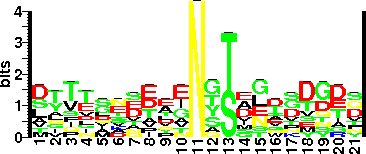| ProGlyProt ID | BC168 |
| Organism Information |
| Organism Name | Pseudomonas aeruginosa PAK /5939 |
| Domain | Bacteria |
| Classification | Family: Pseudomonadaceae
Order: Pseudomonadales
Class: Gammaproteobacteria
Division or phylum: "Proteobacteria" |
| Taxonomic ID (NCBI) | 287 |
| Genome Sequence (s) |
| EMBL | M57501 |
| Gene Information |
| Gene Name | fliC |
| NCBI Gene ID | |
| Protein Information |
| Protein Name | Type a Flagellin |
| UniProtKB/SwissProt ID | P21184 |
| NCBI RefSeq | |
| EMBL-CDS | AAA63458.1 |
| UniProtKB Sequence | >sp|P21184|FLICA_PSEAE A-type flagellin OS=Pseudomonas aeruginosa GN=fliC PE=1 SV=3
MALTVNTNIASLNTQRNLNNSSASLNTSLQRLSTGSRINSAKDDAAGLQIANRLTSQVNG
LNVATKNANDGISLAQTAEGALQQSTNILQRMRDLSLQSANGSNSDSERTALNGEVKQLQ
KELDRISNTTTFGGRKLLDGSFGVASFQVGSAANEIISVGIDEMSAESLNGTYFKADGGG
AVTAATASGTVDIAIGITGGSAVNVKVDMKGNETAEQAAAKIAAAVNDANVGIGAFSDGD
TISYVSKAGKDGSGAITSAVSGVVIADTGSTGVGTAAGVTPSATAFAKTNDTVAKIDIST
AKGAQSAVLVIDEAIKQIDAQRADLGAVQNRFDNTINNLKNIGENVSAARGRIEDTDFAA
ETANLTKNQVLQQAGTAILAQANQLPQSVLSLLR
|
| Sequence length | 394 AA |
| Subcellular Location | Secreted |
| Function | Flagellin is the subunit protein which polymerizes to form the filaments of bacterial flagella. It has been shown to have a role in the stimulation of inflammatory response via Toll-like receptor 5. |
| Protein Structure |
| PDB ID | |
| Glycosylation Status |
| Glycosylation Type | O (Ser/Thr) linked |
| Experimentally Validated Glycosite(s) in Full Length Protein | (Initiator Met removed) T190, S261 |
| Experimentally Validated Glycosite(s ) in Mature Protein | T189, S260
|
| Glycosite(s) Annotated Protein Sequence | >sp|P21184|FLICA_PSEAE A-type flagellin OS=Pseudomonas aeruginosa GN=fliC PE=1 SV=3
MALTVNTNIASLNTQRNLNNSSASLNTSLQRLSTGSRINSAKDDAAGLQIANRLTSQVNG
LNVATKNANDGISLAQTAEGALQQSTNILQRMRDLSLQSANGSNSDSERTALNGEVKQLQ
KELDRISNTTTFGGRKLLDGSFGVASFQVGSAANEIISVGIDEMSAESLNGTYFKADGGG
AVTAATASGT*(190)VDIAIGITGGSAVNVKVDMKGNETAEQAAAKIAAAVNDANVGIGAFSDGD
TISYVSKAGKDGSGAITSAVS*(261)GVVIADTGSTGVGTAAGVTPSATAFAKTNDTVAKIDIST
AKGAQSAVLVIDEAIKQIDAQRADLGAVQNRFDNTINNLKNIGENVSAARGRIEDTDFAA
ETANLTKNQVLQQAGTAILAQANQLPQSVLSLLR
|
| Sequence Around Glycosites (21 AA) | GAVTAATASGTVDIAIGITGG
DGSGAITSAVSGVVIADTGST
|
| Glycosite Sequence Logo | seqlogo |
| Glycosite Sequence Logo |  |
| Technique(s) used for Glycosylation Detection | Slower (and aberrant) migration on SDS-PAGE than its predicted mass, carbohydrate detection and deglycosylation with TFMS |
| Technique(s) used for Glycosylated Residue(s) Detection | LC-ES-MS/MS (liquid chromatography electrospray tandem mass spectrometry) analysis after β-elimination with ammonium hydroxide |
| Protein Glycosylation- Implication | |
| Glycan Information |
| Glycan Annotation | Linkage: Rha-Ser/Thr.
Heterogeneous glycan comprising up to 11 monosaccharide units that are O-linked through a rhamnose (deoxyhexose) residue; rhamnose, mannose, glucose, and 4-amino-4,6-dideoxyglucose (viosamine) as major components with novel, conserved trisaccharide capping. A single rhamnose residue is found at each site in P. aeruginosa JJ692. |
| Technique(s) used for Glycan Identification | Nanospray MS-MS analyses after HPLC of glycopeptide ions and GC-MS (gas chromatography-mass spectrometry) monosaccharide analysis |
| Protein Glycosylation linked (PGL) gene(s) |
| OST Gene Name | pilO (tfpO) |
| OST NCBI Gene ID | |
| OST GenBank Gene Sequence | |
| OST Protein Name | PilO (TfpO) |
| OST UniProtKB/ SwissProt ID | |
| OST NCBI RefSeq | |
| OST EMBL-CDS | |
| OST UniProtKB Sequence | |
| OST EC Number (BRENDA) | 2.4.1.119 |
| OST Genome Context | |
| Characterized Accessory Gene(s) | Glycosyltransferases OrfA and OrfN are encoded in the glycosylation island (long in PAK strain and short in JJ692 strain). These are involved in the addition of the heterologous glycan and the proximal rhamnose residue, respectively. A cluster of 14 genes (OrfA to OrfN) constitute the glycosylation island (GI) that is essential for flagellin glycosylation. |
| PGL Additional Links | CAZy |
| Literatures |
| Reference(s) | 1) Miller, W.L., Matewish, M.J., McNally, D.J., Ishiyama, N., Anderson, E.M., Brewer, D., Brisson, J.R., Berghuis, A.M. and Lam, J.S. (2008) Flagellin glycosylation in Pseudomonas aeruginosa PAK requires the O-antigen biosynthesis enzyme WbpO. J Biol Chem, 283, 3507-3518. [PubMed: 18065759]
2) Arora, S.K., Wolfgang, M.C., Lory, S. and Ramphal, R. (2004) Sequence polymorphism in the glycosylation island and flagellins of Pseudomonas aeruginosa. J Bacteriol, 186, 2115-2122. [PubMed: 15028697] |
| Additional Comments | Post translational modification was detected in the year 1990. It was confirmed as glycosylation in 1998. |
| Year of Identification | 1998 |
| Year of Validation | 2004 |


